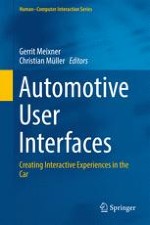2017 | OriginalPaper | Buchkapitel
8. The Influence of Non-driving-Related Activities on the Driver’s Resources and Performance
verfasst von : Renate Häuslschmid, Bastian Pfleging, Andreas Butz
Erschienen in: Automotive User Interfaces
Aktivieren Sie unsere intelligente Suche, um passende Fachinhalte oder Patente zu finden.
Wählen Sie Textabschnitte aus um mit Künstlicher Intelligenz passenden Patente zu finden. powered by
Markieren Sie Textabschnitte, um KI-gestützt weitere passende Inhalte zu finden. powered by
